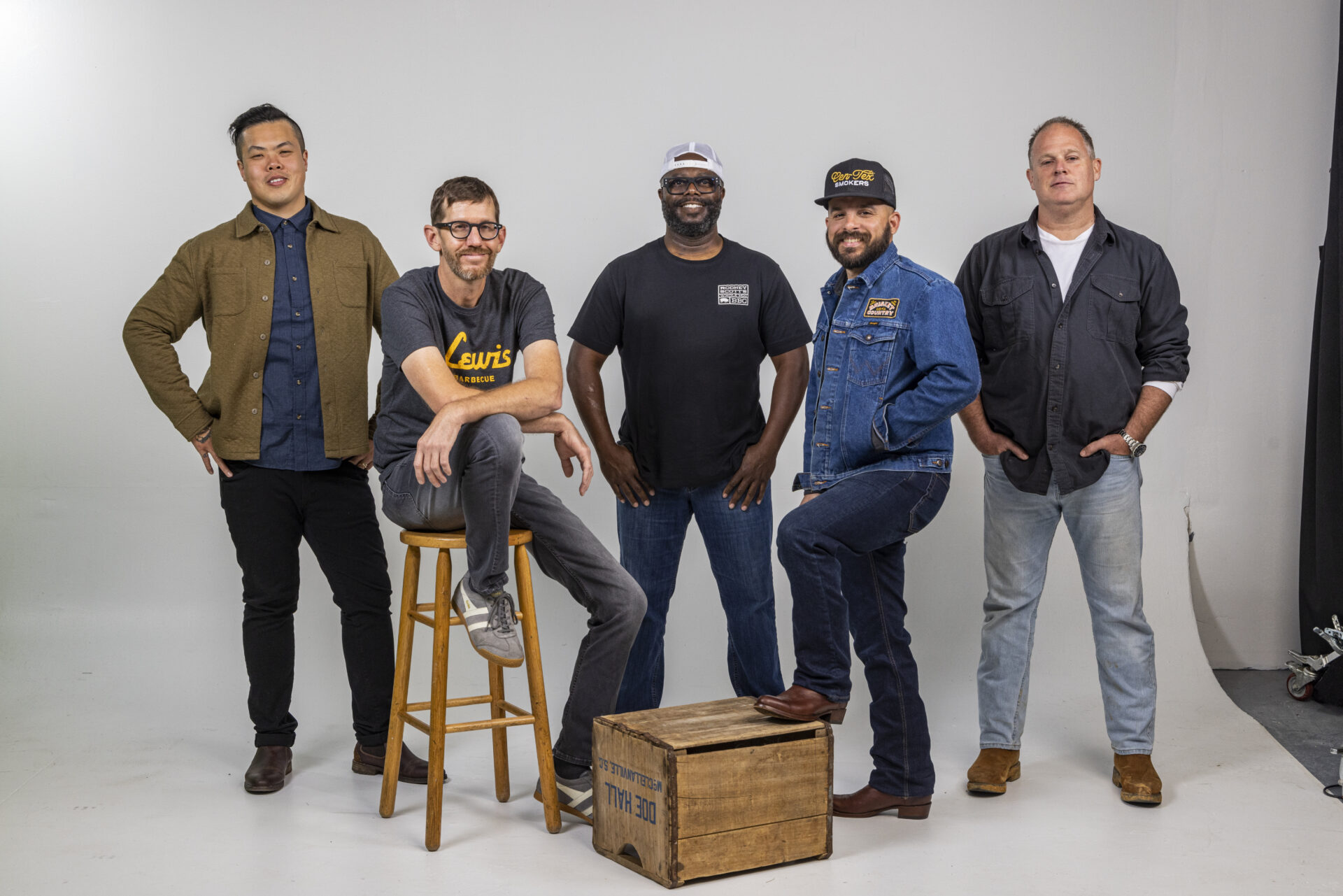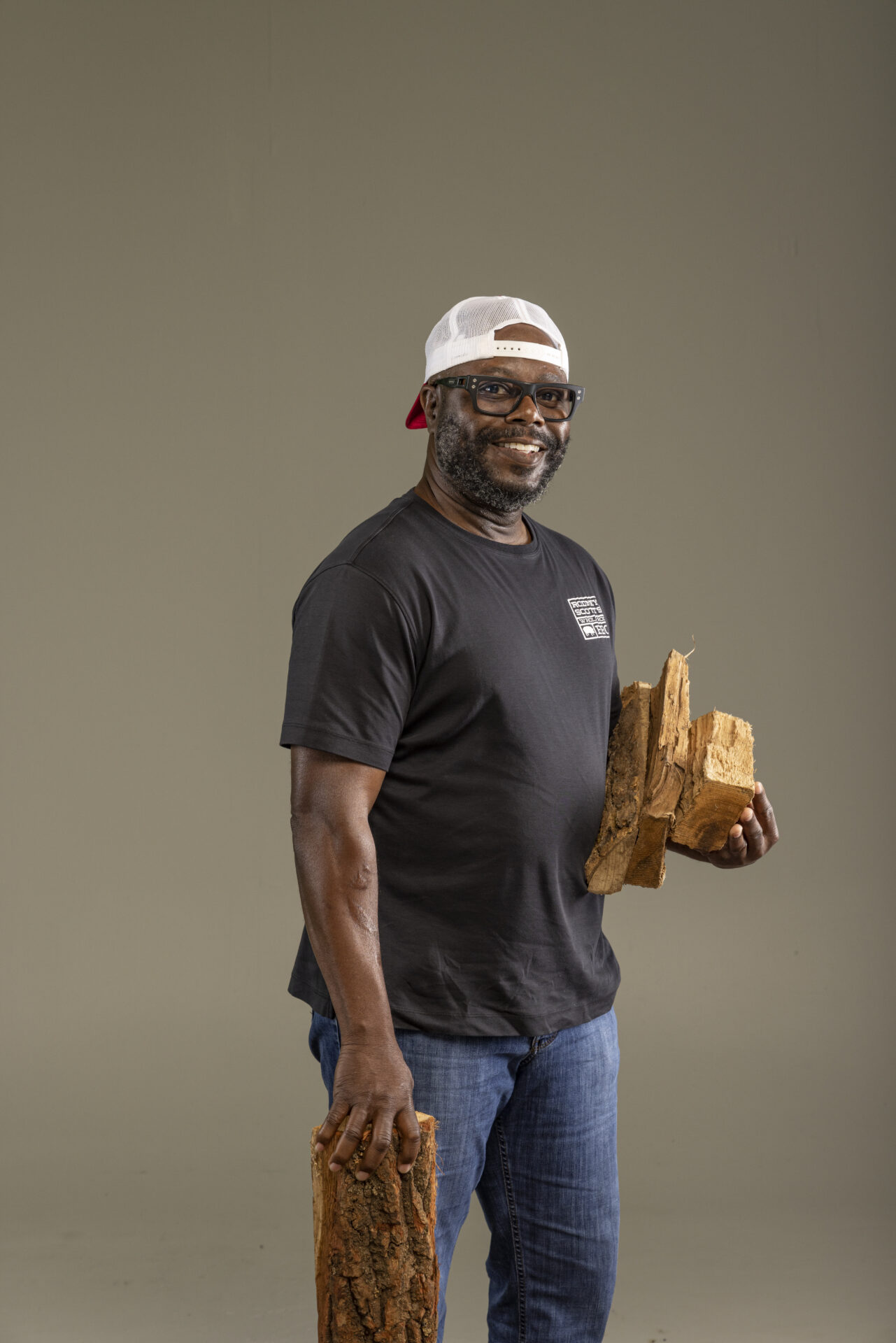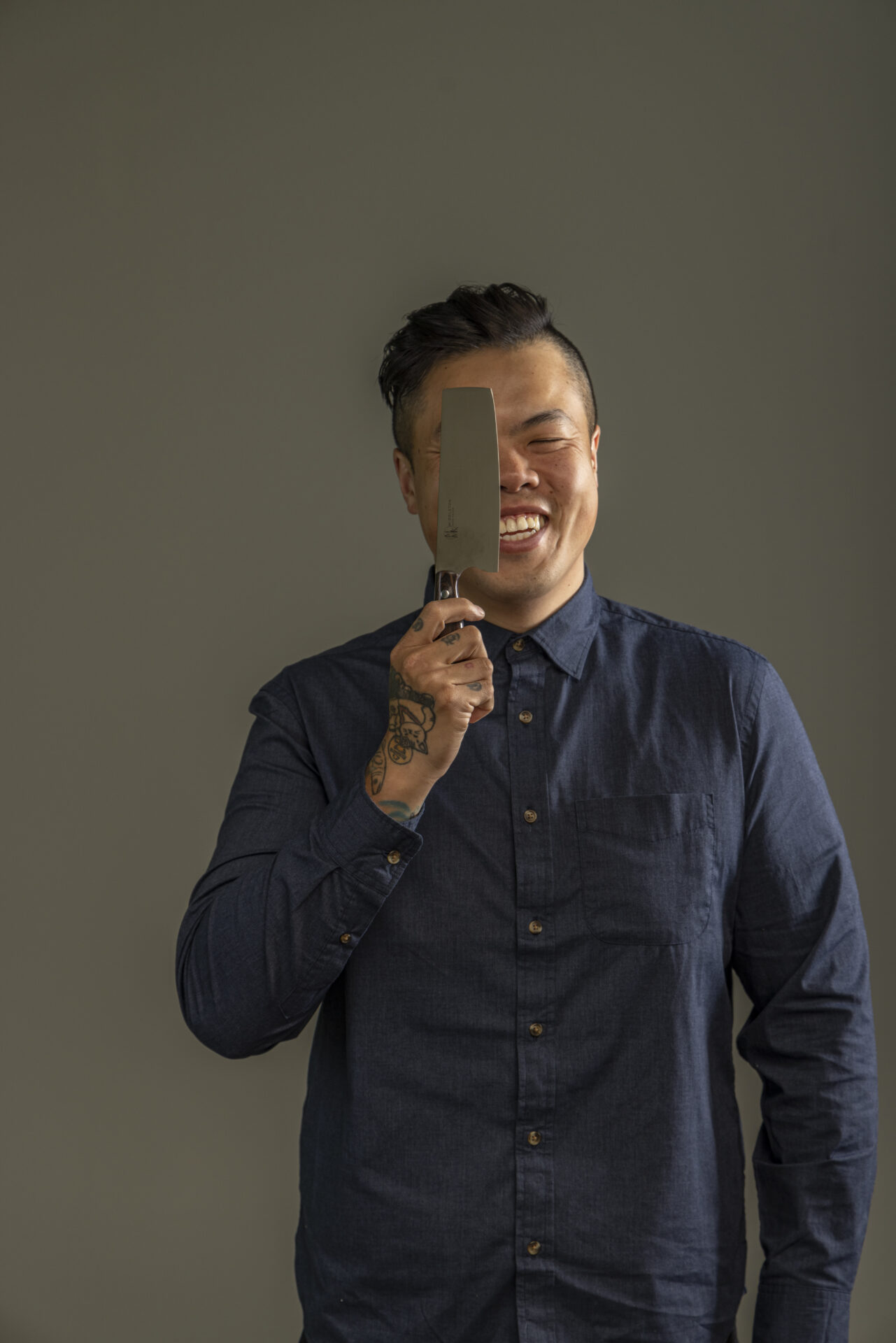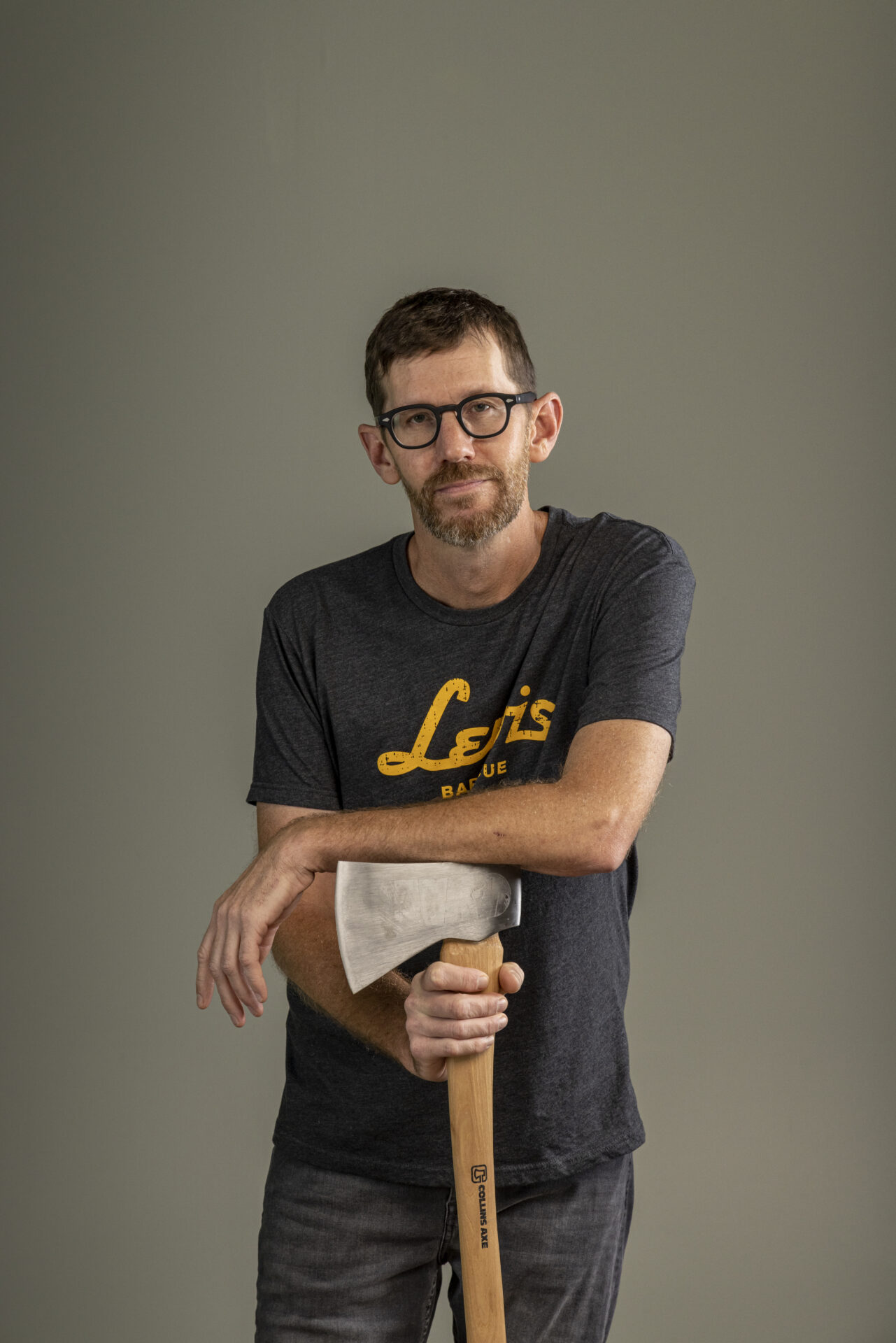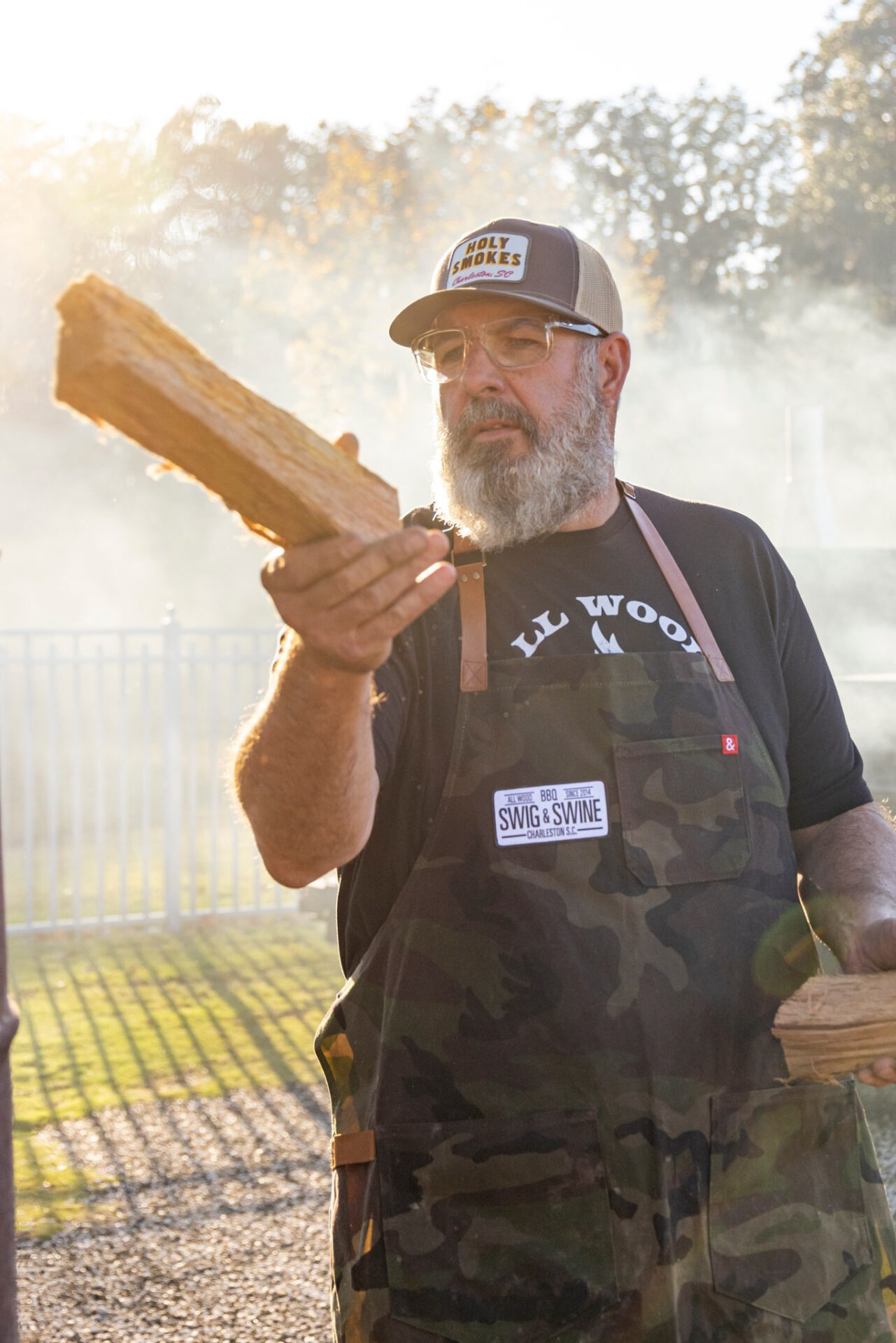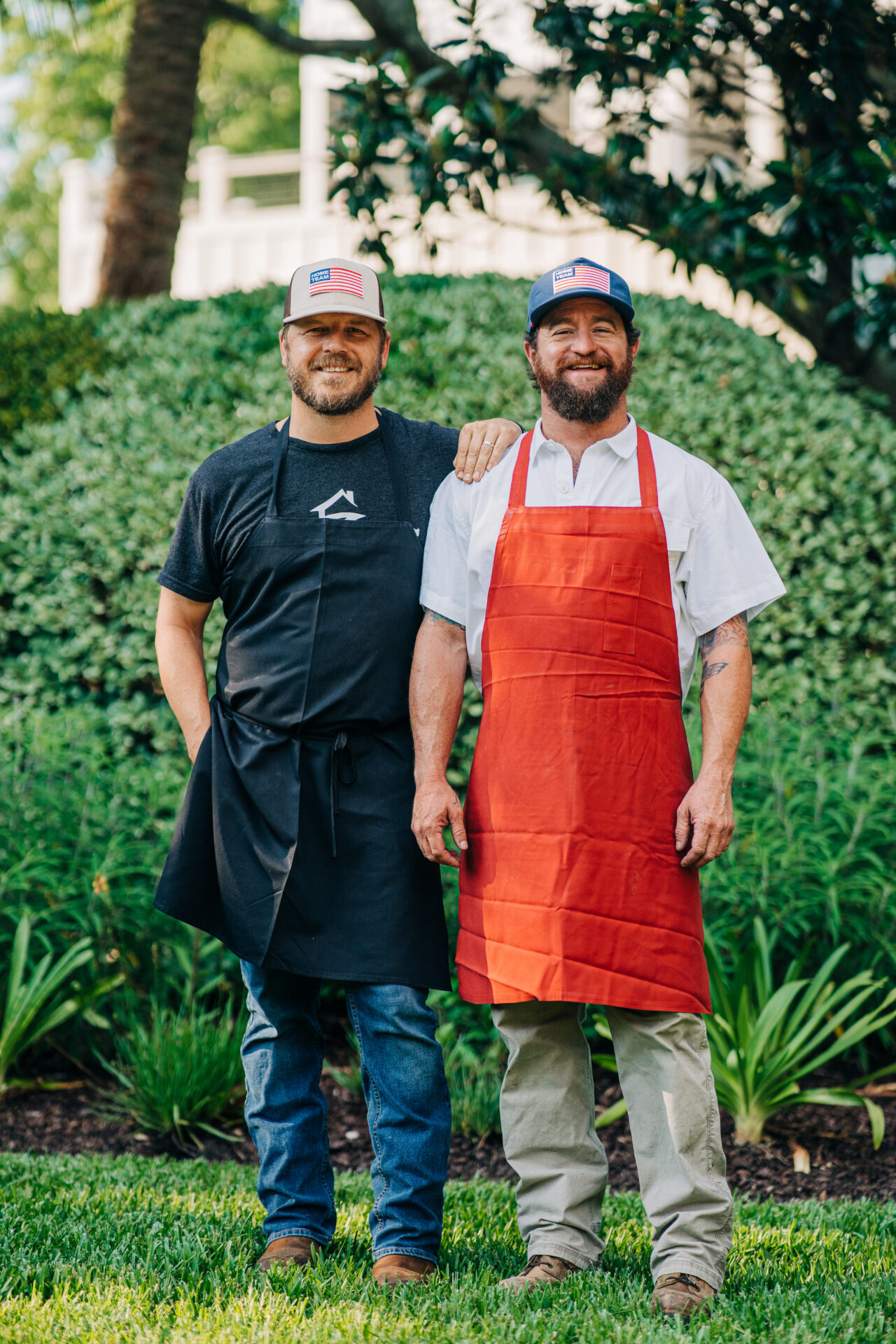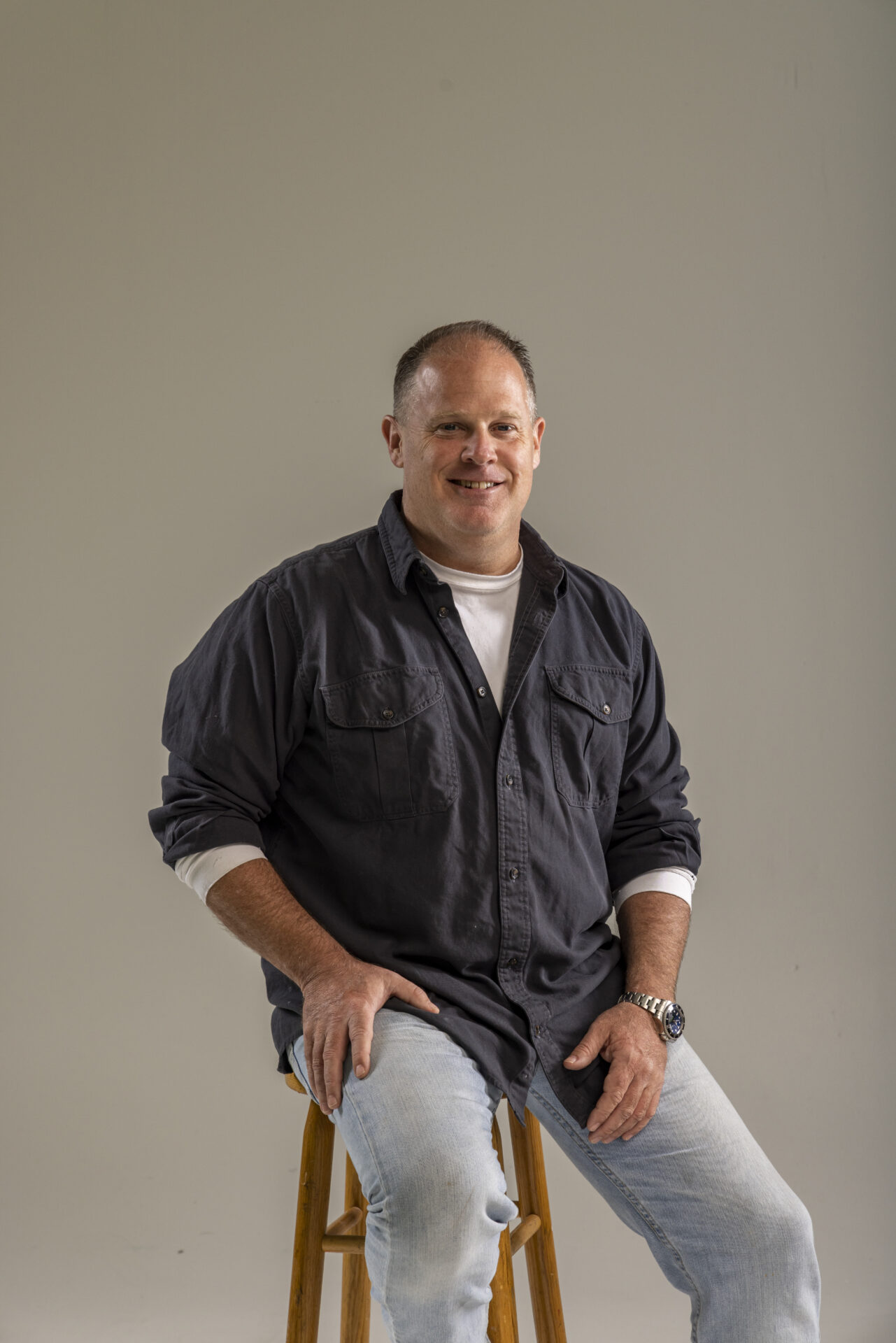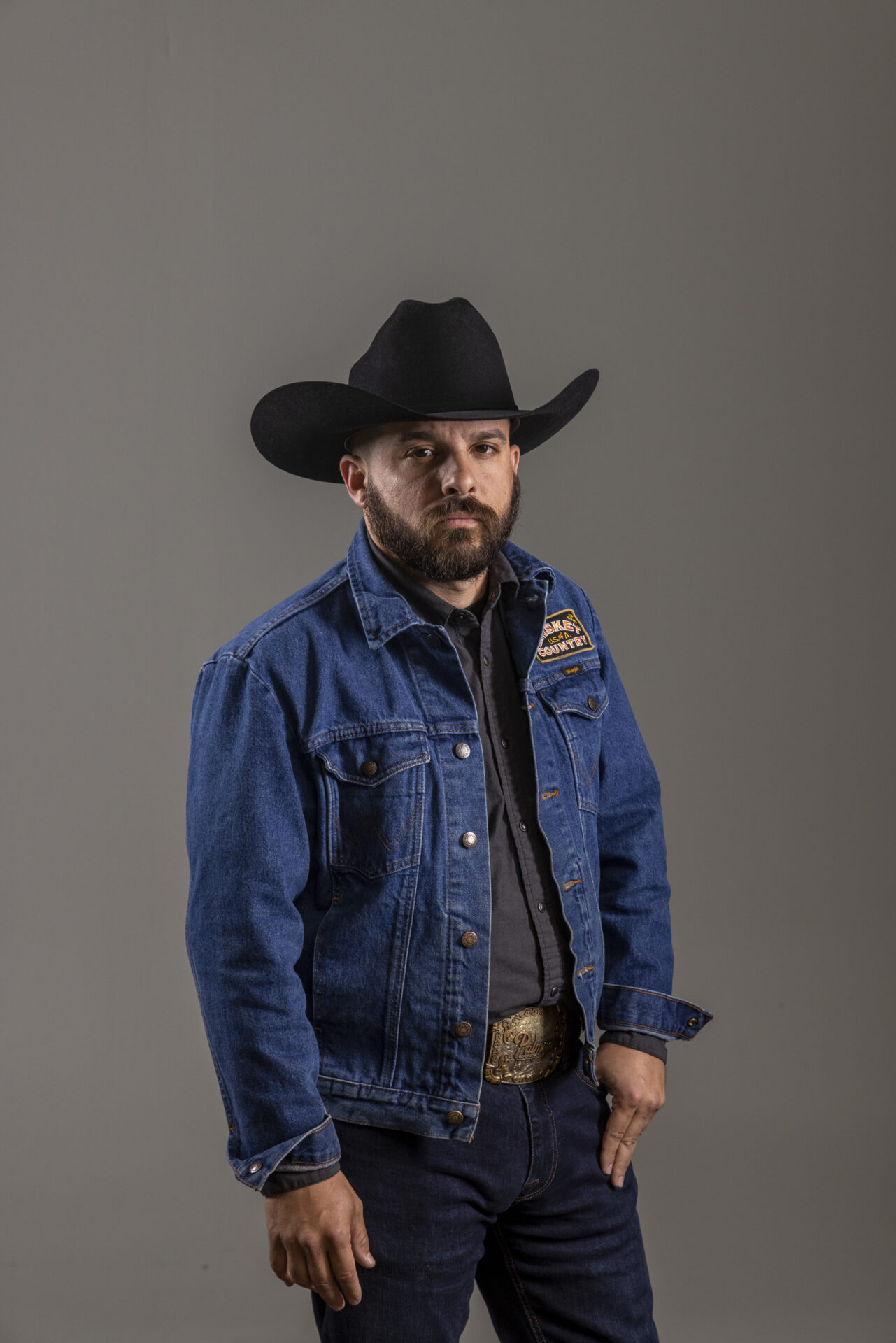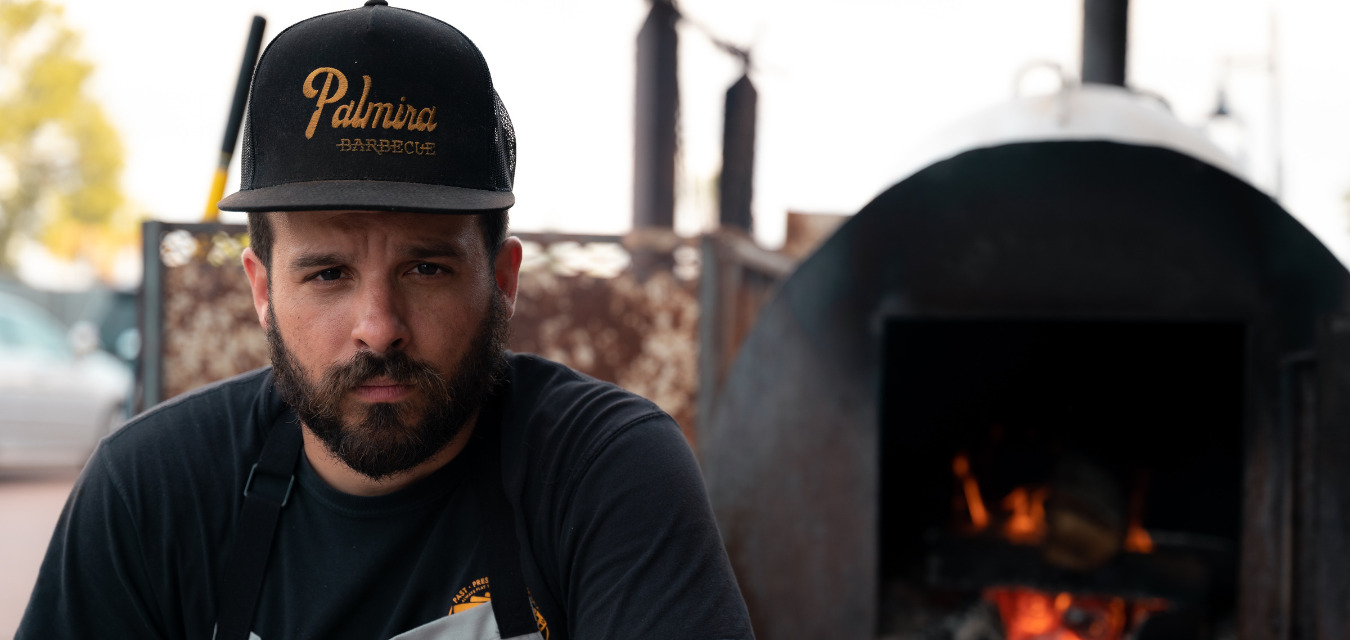Not far from Charleston, you can easily find your way to Eastern and Western Carolina styles of barbecue. But here? Barbecue is transcending boundaries. The city’s pitmasters are defining their own style, complete with pulled whole hog, Texas-style brisket, dry-spiced ribs, and hot guts sausages—plus a dash of Puerto Rican heritage and Chinese influences to season the mix. Grab a tray and come hungry: These Charleston pitmasters are ready to load your plate with their distinct styles of ’cue.
Rodney Scot
Rodney Scott’s Whole Hog BBQ (Downtown)
When Rodney Scott made the leap from running his family’s barbecue pit in Hemingway, South Carolina, to owning his own place in Charleston in 2017, the city went nuts for his platters of pulled whole hog and ribs. Throw in a James Beard Award for Best Chef: Southeast in 2018, and Scott became a bona fide local food celeb. With locations in Alabama, Atlanta, and soon-to-open Nashville, Scott is living out a pitmaster’s dream—but Charleston will always be his first.
TLP: What are your preferred tools for making barbecue?
Rodney Scott: In my restaurants I use a custom-made pit. But my preferred pit is usually cinder block, especially if I’m remote. My stuff is pretty primitive, so a cinder block pit, a shovel to bury my wood, wire, wire cutters, and rebar.
TLP: Which local pitmasters have been your biggest supporters?
RS: Tay [Nelson] of Bobby’s BBQ [in Fountain Inn, South Carolina] has been a huge supporter. He’ll drive down from the Upstate to help us cook sometimes. And then we have the guys here in Charleston, Swig & Swine and Home Team—Aaron [Siegel] and those guys have always been huge supporters.
TLP: What’s your go-to barbeque in Charleston (that’s not your own)?
RS: Okay, this is a loaded question. But I will tell you this: I eat a lot of barbecue from a friend of mine, we call him Billy Brisket. He doesn’t do barbecue for a living, but he does a lot at home. And every time he does barbecue, because he lives so close, he will call and I’ll just go over there and grab some. So Billy is the guy—and that’s top-secret info right there.
Shuai Wang
King BBQ (North Charleston)
As soon as Shuai and Corrie Wang brought Shuai’s particular style of heritage-driven New Chinese-American to North Charleston in the form of Jackrabbit Filly, we were hooked—and could probably eat his Sichuan hot karaage every damn day. And then he announced a pop-up, King BBQ, last year so that he and chef de cuisine and pitmaster Brandon Olson could showcase an ode to Chinese barbecue married with Southern smoke. After months of sell-out events and a standing Sunday Supper at Jackrabbit Filly, the team is opening a brick-and-mortar location this year, celebrating Shuai’s heritage in the form of Chinese sausage, roast duck, and pork belly sliders.
TLP: Tell us about what led you to open King BBQ.
Shuai Wang: Opening King BBQ was driven mainly by the idea of missing that old-school Chinatown Chinese barbecue shop, with the glorious hanging ducks in the window, cha shao, roast pig, and soy sauce chicken. At King, we will be paying tribute to Chinese-style barbecue but also Southern smoke.
TLP: What are you preferred tools for making Chinese barbecue?
SW: We’re starting with Lang offset cookers [and] also utilizing an Alto-Shaam rotisserie oven to roast our ducks and chickens, as well as our rotisserie vegetarian barbecue. As far as wood goes, we’ll mainly be using white oak. Chinese barbecue is never smoked, so we just need a little something-something to get that great smoky essence.
TLP: What goes onto your own barbeque plate?
SW: I love a good pork rib, just tender enough but still with a little bite to it. I also love a really good slaw. Sam Jones [of Sam Jones BBQ in Greenville and Raleigh, North Carolina] probably has my favorite slaw. And lastly, a good hash and rice.
John Lewis
Lewis Barbeque (Downtown)
Texas native John Lewis first set up his smoker in Charleston in 2016—but not before he’d worked with some of the best pitmasters in Texas, including Aaron Franklin and LeAnn Mueller. He also came with a skill and passion for building his own smokers, which he crafted specifically to put out his Texas-style brisket and legendary “hot guts” sausages. Lewis has gone on to open Rancho Lewis, an ode to Texas and Southwestern cuisine, as well as a second location of Lewis Barbecue in Greenville, South Carolina. But his original downtown location is still a crowd (and crowded) favorite for brisket, sausage, turkey breast, pulled pork, and more.
TLP: Have your methods for making barbeque evolved?
John Lewis: Our barbecue method has been pretty locked in since we opened in 2016, but we’ve definitely evolved in terms of the menu. When we first opened, I wanted to stick to the classics that I grew up with in Texas: brisket, hot guts sausage, and beef ribs. Once we got our footing in Charleston and introduced ourselves to the community, we felt like we could get creative with specials like smoked pork belly, chicken fried steak, and smoked prime rib. We also developed a signature barbecue sauce made with hatch green chiles that I’m really proud of.
TLP: What are your preferred tools for making barbeque?
JL: I make all our pits with my dad, so the style of smoker is pretty unique. We weld them out of 1,000-gallon propane tanks with a few “secrets” that I think make the perfect vessel for barbecue. I’m also very particular about the wood we use: It’s a mix of local white and red oak.
TLP: What goes onto your own barbeque plate?
JL: I like the contrast of smoky meat with something tart and light, so I’m normally loading up on our vinegar-based slaw. I’m also a big fan of our hatch green chile corn pudding—it tastes like home.
Anthony Dibernardo
Swig & Swine (West Ashley, Summerville, Mount Pleasant)
Since 2012, Anthony DiBernardo (and his big, friendly personality) has been serving up slow-cooked whole hog barbecue, sausage, and ribs to legions of loyal fans. A former cook for the US Navy, DiBernardo also worked in fine dining at spots like Kiawah Island Resort before turning his attention to smoked meats. Today, he custom builds his own smokers, uses only wood to fire them, and at three locations around town, continues to put out some of the city’s most reliably consistent, mouthwatering ’cue.
TLP: How has your style of making barbeque changed over the years?
Anthony Dibernardo: I am constantly evolving our procedures and processes to try and make the best and most consistent barbecue we can.
TLP: What are your preferred barbeque tools?
AD: At Swig & Swine we use a combination of wood-burning rotisseries, direct cookers, and offsets to cook our barbecue on a daily basis.
TLP: What’s the most-ordered item on your menu (besides pulled pork)?
AD: The burnt ends, which we do often, are the most requested.
TLP: What are you most excited about in today’s Charleston barbeque scene?
AD: I’m excited about the addition of Palmira Barbecue and King BBQ to the Charleston barbecue scene. I am also very excited to bring Swig & Swine to Moncks Corner and Myrtle Beach later this year.
Aaron Siegel & Taylor Garrigan
Home Team BBQ (Downtown, Mount Pleasant, Sullivan’s Island, West Ashley)
One of Charleston’s longest-standing barbecue joints, Home Team opened in West Ashley in 2006 as Fiery Ron’s Home Team BBQ (an ode to founding chef Aaron Siegel’s nickname). Siegel was trained in more classical cuisines but developed a love for smoked meats working under chef Craig Deihl at Cypress. At Home Team, he and his partners, including Taylor Garrigan, have honed their craft and expanded their menu with items like their ever-popular smoked wings.
TLP: What are your preferred tools for making barbeque?
Aaron & Taylor: We use two kinds of smokers: an offset-reverse flow and a rotisserie with convection. Both are fed by red or white oak and charcoal. We love to use any type of open fire, especially with a cast-iron skillet like Smithey Ironware. We’ve built several grill/cooking apparatuses, but our favorite is the Ron-o-gon, an eight-sided open-fire grill with adjustable levels.
TLP: Which local pitmasters have been your greatest supporters?
A & T: Anthony DiBernardo of Swig & Swine has been great to work alongside over the years. We’ve partnered together on a bunch of events like Holy Smokes and Rock the Block. Rodney [Scott] has always been a good friend and an inspiration, and he’s just a good buddy to hang out with.
TLP: What are you most excited about in Charleston’s barbeque scene?
A & T: The growing diversity of barbecue. That’s something we set out to do in 2006 when we opened our first restaurant: the idea that you can do a lot more with barbecue than just put it on a plate with a couple of sides. You can get so many different types of barbecue in Charleston these days. That wasn’t the case a few years ago.
Pat Martin
Martin’s Bar-B-Que Joint (James Island)
A champion of Western Tennessee-style whole hog barbecue, Pat Martin has developed a loyal following for his particular style of ’cue. But he also knows it’s about atmosphere. Martin’s James Island location is a casual, low-key hang where you can kick back and enjoy the vibe, complete with indoor and outdoor seating, picnic tables, a solid bar, and, of course, all the smoked meats you might need, from pulled pork and brisket to smoked bologna and turkey.
TLP: Which local pitmasters have been your greatest supporters?
Pat Martin: I’ve been friends for a long time with this crew of pitmasters, especially the Home Team boys, Anthony [DiBernardo], and Rodney [Scott].
TLP: What are your preferred tools for making barbeque?
PM: I prefer a cinder block pit with hickory wood when cooking whole hog.
TLP: What goes onto your own barbeque plate?
PM: Whole hog sandwich with slaw on top and baked beans.
TLP: What are you most excited about in today’s Charleston barbecue scene?
PM: I really like the diversity of options going on right now.
Hector Garate
Palmira Barbecue (West Ashley)
Hector Garate describes his barbecue as being inspired by Central Texas, the Carolinas, and his Puerto Rican roots. His pop-up, Palmira (pronounced “pal meer-a”), which he launched in 2016, has taken him as far as Texas, but he will soon set down roots in a new location in West Ashley. On the menu? Whole hog pulled pork, barbacoa, and his sofrito-laced hash and rice.
TLP: How did you get into barbeque?
Hector Garate: My wife got me an offset smoker and I was like, okay, now I have to figure out how to cook with it. So, I started cooking brisket Texas-style because it was basically what I thought would do well. But what that smoker taught me wasn’t how to cook meat. It was how to manage fire.
TLP: Describe your style of barbeque.
HG: It has a Puerto Rican influence. We use offset smokers, which are well-known as a Central Texas-style of smoker, but we also do direct heat, which is what we would do in Puerto Rico, and it’s similar to what you find in the Carolinas—there are a lot of similarities, in fact. But then, I also add flavor with sofrito, different spices; I do my own adobo. In the Carolinas, it will be a lot of salt, maybe some vinegar. I like food that is highly seasoned—when you taste it, it’s like, wow.
TLP: How do you set yourself apart as a pitmaster?
HG: You have to embrace who you are. I embrace my culture. If I see something somebody else is doing that I think is better, yeah, I’m going to try it. But at the same time, you know, by staying in my lane, I’m creating my own barbecue by taking the best of these other styles and adding my own. So far, it has worked out—for me and my customers.
keep reading
At the Table
10 Fresh Barbecue Sides to Upgrade the Cookout
Nine southern chefs share their favorite unconventional barbecue sides ranging from zesty kimchi slaw to rich corn pudding.
From the Magazine
Letter From the Editor: Our Insider’s Guide To Charleston Is Here
The Local Palate officially unveils our insider’s guide to Charleston. Read on for our noteworthy new favorites or our tried and true spots.
Cook the Book
Cook the Book: Ed Mitchell’s Barbeque
Digital Editor, Amber Chase, shares her journey through the recent cookbook by Ed Mitchell, tackling everything from brisket to hushpuppies.
share
trending content
-
In the Spirit: Distillery of Modern Art (DoMA) | Listen
by Amber Chase -
Asian Food Booms In the South
by TLP Editors -
Stirrups Restaurant Offers Fine Dining Like Nowhere Else
-
Our Summer 2024 Issue is Here!
by Erin Byers Murray -
9 Noteworthy Kentucky Restaurants | Listen
by TLP Editors
More From From the Magazine
-
Asian Food Booms In the South
-
Our Summer 2024 Issue is Here!
-
Will Travel for Southern Food | Listen
-
In the Fridge with Vivian Howard
-
Forage to Ferment with Preserved Mint





